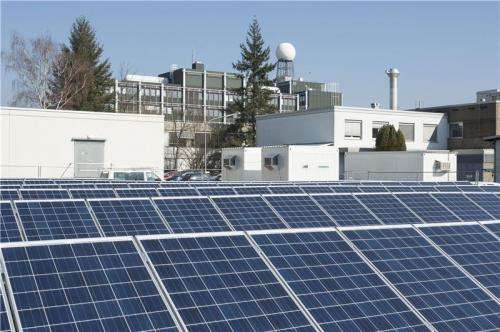Enhancing safety of domestic solar power storage

Lithium-ion battery-based energy storage systems have already demonstrated how efficient, reliable, and safe they can be in commercial electric vehicles. These high safety standards now also have to be transferred to battery-based storage systems for private photovoltaics facilities. At the Intersolar leading trade fair in Munich that will start on June 04, 2014, KIT will present solutions for the design of safe and long-lived PV domestic storage systems.
"Lithium-ion batteries can reach a very high operational reliability, if the manufacturer possesses the necessary know-how and observes some "golden rules"," explains Dr. Olaf Wollersheim of the Competence E project of Karlsruhe Institute of Technology (KIT). He and his team analyzed the transport safety and operational reliability of stationary batteries and formulated corresponding guidelines. "These guidelines may serve as a checklist to help laymen separate the wheat from the chaff." Stationary batteries store solar power and, in this way, eliminate the production peak at noon. This power is then released again in the evening, during the night or in the morning when it is needed. Area-wide balancing of power production and power demand would be an important element for the energy turnaround.
Unfortunately, not all manufacturers on the young market of domestic storage systems apply the "golden rules" for battery safety. These include the UN38.3 certificates on the battery and cell levels, the draft DIN EN 62619, and functional safety checks according to the ISO safety integrity level (SIL). "The branch is obliged to ensure safety for its customers and to actively promote observation of the standards." Reports of fire brigades reveal that there are black sheep in the branch. In some cases, defective battery storage systems were found to be the cause of fires. Recent own tests of commercial stationary battery storage systems by the Competence E project demonstrated that some of these systems do not correspond to the safety standards.
Yet, stationary energy storage systems can be constructed and operated reliably by using comparably simple measures. "Automotive industry that develops and produces lithium-ion batteries with extraordinary care shows how this can be done. The standards used there have to be transferred to domestic storage systems for the black sheep to disappear," Dr. Andreas Gutsch, the coordinator of the Competence E project, explains. By all-pole battery shutdown, for instance, i.e. the disconnection of both battery poles from the mains, overcharging due to excess voltage may be prevented when switches are activated by independent safety systems. "The necessary know-how has to be developed by every company that wishes to produce domestic storage systems. Citizens, who want to support the energy turnaround by installing a domestic storage system, are entitled to a maximum safety." Current research focuses on this issue.
More information: www.kit.edu/downloads/KIT_Li-Ionen_Checkliste.pdf
Provided by Karlsruhe Institute of Technology




















